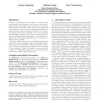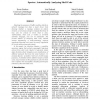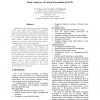18 search results - page 3 / 4 » Deobfuscation: Reverse Engineering Obfuscated Code |
DRM
2007
Springer
13 years 12 months ago
2007
Springer
The goal of obfuscation is to transform a program, without affecting its functionality, such that some secret information within the program can be hidden for as long as possible...
CASES
2004
ACM
13 years 11 months ago
2004
ACM
+ With more applications being deployed on embedded platforms, software protection becomes increasingly important. This problem is crucial on embedded systems like financial transa...
VEE
2012
ACM
12 years 1 months ago
2012
ACM
Process-level virtualization is increasingly being used to enhance the security of software applications from reverse engineering and unauthorized modification (called software p...
ACSAC
2007
IEEE
14 years 3 days ago
2007
IEEE
Detecting the presence of buffer overflow attacks in network messages has been a major focus. Only knowing whether a message contains an attack, however, is not always enough to m...
ACSAC
2004
IEEE
13 years 9 months ago
2004
IEEE
Software security assurance and malware (trojans, worms, and viruses, etc.) detection are important topics of information security. Software obfuscation, a general technique that ...



